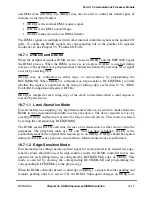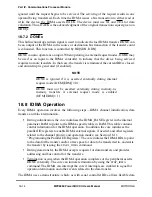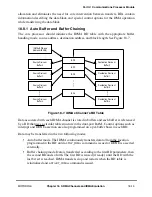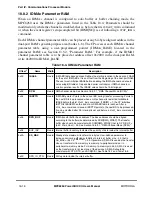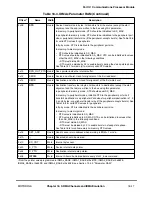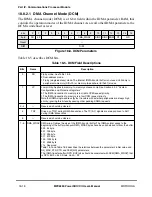
18-27
MPC8260 PowerQUICC II UserÕs Manual
MOTOROLA
Part IV. Communications Processor Module
In external request mode (ERM = 1),
STOP
_
IDMA
command processing has priority over a
peripheral asserting DONE.
Note: In memory-to-peripheral, peripheral-to-memory, and ßy-by modes, if a
STOP
_
IDMA
command is issued with no data in the internal buffer, the BD is immediately closed and the
channel is stopped. In this case, a peripheral expecting DONE to be asserted is not notiÞed
because the last transfer of the buffer (with BD[DDN or SDN] set) is not performed.
18.10 IDMA Bus Exceptions
Bus exceptions can occur while the IDMA has the bus and is transferring operands. In any
computer system, a hardware failure can cause an error during a bus transaction due to
random noise or an illegal access. When a synchronous bus structure (like those supported
by the MPC8260) is used, it is easy to make provisions for a bus master to detect and
respond to errors during a bus transaction. The IDMA recognizes the same bus exceptions
as the core, reset and transfer error, as described in Table 18-11.
18.10.1 Externally Recognizing IDMA Operand Transfers
The following ways can be used determine externally that the IDMA is executing a bus
transaction:
¥
The TC[2] signal (programmed in DCM[TC2]) or SDMA channels can be
programmed to a unique code that identiÞes an IDMA transfer.
¥
The DACK signal shows accesses to the peripheral device. DACK activates on either
the source or destination bus transactions, depending on DCM[S/D].
Table 18-11. IDMA Bus Exceptions
Exception
Description
Reset
On an external reset, the IDMA immediately aborts the channel operation, returns to the idle state, and
clears IDSR. If reset is detected when a bus transaction is in progress, the transaction is terminated, the
control and address/data pins are three-stated, and bus mastership is released.
Transfer
Error
When a fatal error occurs during a bus transaction, a bus error exception is used to abort the transaction
and systematically terminate channel operation. The IDMA terminates the current bus transaction,
signals an error in the SDSR, and signals an interrupt if the corresponding bit in the SDMR is set. The
CPM must be reset before IDMA operation is restarted. Any data previously read from the source into the
internal storage is lost, however, issuing a
START
_
IDMA
command transfers the last BD again.
Note: Any source or destination device for an operand under IDMA handshake control for single-address
transfers may need to monitor TEA to detect a bus exception for the current bus transaction. TEA
terminates the transaction immediately and negates DACK, which is used to control the transfer to/from
the device.
Summary of Contents for MPC8260 PowerQUICC II
Page 1: ...MPC8260UM D 4 1999 Rev 0 MPC8260 PowerQUICC II UserÕs Manual ª ª ...
Page 66: ...lxvi MPC8260 PowerQUICC II UserÕs Manual MOTOROLA ...
Page 88: ...1 18 MPC8260 PowerQUICC II UserÕs Manual MOTOROLA Part I Overview ...
Page 120: ...2 32 MPC8260 PowerQUICC II UserÕs Manual MOTOROLA Part I Overview ...
Page 138: ...Part II iv MPC8260 PowerQUICC II UserÕs Manual MOTOROLA Part II Configuration and Reset ...
Page 184: ...4 46 MPC8260 PowerQUICC II UserÕs Manual MOTOROLA Part II ConÞguration and Reset ...
Page 202: ...Part III vi MPC8260 PowerQUICC II UserÕs Manual MOTOROLA Part III The Hardware Interface ...
Page 266: ...8 34 MPC8260 PowerQUICC II UserÕs Manual MOTOROLA Part III The Hardware Interface ...
Page 382: ...10 106 MPC8260 PowerQUICC II UserÕs Manual MOTOROLA Part III The Hardware Interface ...
Page 392: ...11 10 MPC8260 PowerQUICC II UserÕs Manual MOTOROLA Part III The Hardware Interface ...
Page 430: ...Part IV viii MOTOROLA Part IV Communications Processor Module ...
Page 490: ...14 36 MPC8260 PowerQUICC II UserÕs Manual MOTOROLA Part IV Communications Processor Module ...
Page 524: ...17 10 MPC8260 PowerQUICC II UserÕs Manual MOTOROLA Part IV Communications Processor Module ...
Page 556: ...18 32 MPC8260 PowerQUICC II UserÕs Manual MOTOROLA Part IV Communications Processor Module ...
Page 584: ...19 28 MPC8260 PowerQUICC II UserÕs Manual MOTOROLA Part IV Communications Processor Module ...
Page 632: ...21 24 MPC8260 PowerQUICC II UserÕs Manual MOTOROLA Part IV Communications Processor Module ...
Page 652: ...22 20 MPC8260 PowerQUICC II UserÕs Manual MOTOROLA Part IV Communications Processor Module ...
Page 668: ...23 16 MPC8260 PowerQUICC II UserÕs Manual MOTOROLA Part IV Communications Processor Module ...
Page 758: ...27 28 MPC8260 PowerQUICC II UserÕs Manual MOTOROLA Part IV Communications Processor Module ...
Page 780: ...28 22 MPC8260 PowerQUICC II UserÕs Manual MOTOROLA Part IV Communications Processor Module ...
Page 874: ...29 94 MPC8260 PowerQUICC II UserÕs Manual MOTOROLA Part IV Communications Processor Module ...
Page 920: ...31 18 MPC8260 PowerQUICC II UserÕs Manual MOTOROLA Part IV Communications Processor Module ...
Page 980: ...A 4 MPC8260 PowerQUICC II UserÕs Manual MOTOROLA Appendixes ...
Page 1002: ...Index 22 MPC8260 PowerQUICC II UserÕs Manual MOTOROLA INDEX ...
Page 1006: ......

